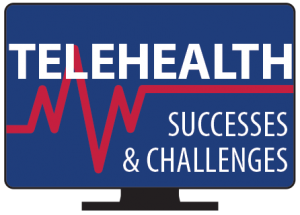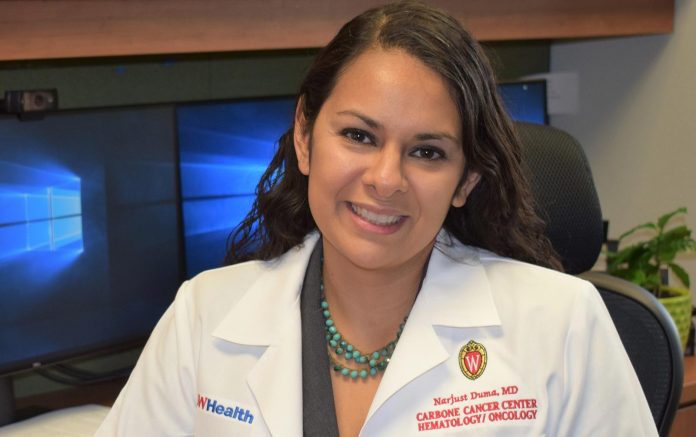 By Narjust Duma, MD
By Narjust Duma, MD
Posted: June 10, 2020
During the past 8 weeks, we have heard how many of our colleagues and cancer centers are switching to telehealth. Two things are clear during this pandemic. The first is that cancer centers cannot wait—most cancer procedures and treatments are not elective, and our patients need their systemic therapies and bronchoscopies with stent placement to breathe or continue breathing. Second, the risk of infection with SARS-CoV-2 will remain high for our patients with lung cancer for the next several months. These two issues prompted the fast introduction and implementation of telehealth in our clinics.
The term telehealth can be used for several types of communication methods with our patients. The basis of telehealth in the current environment is to reduce office visits and face-to-face encounters with our patients. We, as healthcare workers, are at high risk of being asymptomatic vectors for the virus, thereby exposing our most vulnerable patients. Visits over the phone or video constitute the most common forms of telehealth used in thoracic oncology.
The Importance of Touch
I previously confessed that “I am a hugger”; seeing patients, hugging them (with their permission), and walking them to places after our appointments are some of my favorite parts of my job as an oncologist.1 Human interaction is and will remain essential for oncology care. Many of us joined this specialty because we appreciate human interaction and value literally walking with our patients during their cancer journey.
Eight weeks ago (or more), everything changed, and now we must show our love to our patients by staying away from them.
Widening—Not Bridging—Gaps
Initially, I was excited about the introduction of telehealth to our clinic; I was happy that many of my patients did not have to drive to Madison to receive care, and the ones getting intravenous infusions would decrease their risk of getting COVID-19. I believe telehealth has a role in caring for patients with cancer: it can increase access to care in rural areas of the country, it provides an alternative method for patients who may be too weak to leave their houses, and it can facilitate the introduction of palliative care.2 Sadly, reality hit. Telehealth is not an option for all, and it can widen some of the existing cancer health disparities.
Sara is a 69-year-old woman with metastatic lung cancer who is receiving targeted therapy and working full time at her chicken farm. When I introduced the idea of telehealth, Sara was not receptive—she was short on the phone (unusual for her), and after 2 minutes of talking about possible side effects from her medication and plans for blood work, she quickly ended our conversation. The same happened during our telehealth phone call “everything was OK,” even the chickens. During our face-to-face visits, I always got stories and complaints about the chickens. I was puzzled; Sara was not acting like herself. I later learned that she has a very limited phone plan, and she was saving phone minutes to talk with her grandchildren despite having questions for me.
Over the weeks, I sadly learned that Sara’s situation is common for many of my patients; they have limited minutes to talk on the phone, they do not have access to the internet, and, for one patient, the closest phone on which to receive a call is at the farm next door.
Another common obstacle encounter while using telehealth is that many patients do not feel comfortable with or have never used a video conference app before. Our schedulers are calling our patients and are walking them through how to use our video soft ware, but many of my patients are not interested in learning despite the best efforts by staff. Phrases like “Let’s do it over the phone” and “I am too old to learn all of this” were commonly shared with our team. Our comfort level using this technology should not be taken for granted, and we should not assume that all of our patients want or have the technical knowledge to use our new fancy telehealth tools.
I have completed several telehealth encounters using interpreters; the lack of context and body language made the interpretation, as well as the medical visit, more challenging. It left patients feeling like they were not heard due to existing language barriers.
Additional challenges include reimbursement (phone calls), possible delays in diagnosis and treatment, and the unknown consequences to the patient–physician relationship.
Despite the challenges described above, I believe telehealth is here to stay. I suggest that physicians participate in developing strategies to diminish some of the disparities that may be widened by its use and understand that this set of tools may not work for all of our patients with lung cancer. ✦
About the Author: Dr. Duma is an assistant professor at the University of Wisconsin School of Medicine and Public Health. She is an active IASLC volunteer, serving on both the IASLC Communications Committee and the ILCN Editorial Board. You can follow Dr. Duma on Twitter @NarjustDumaMD.
References:
1. Duma N. An oncologist’s perspective of COVID- 19: “I wish I could hug you.” Oncology Central. Published March 31, 2020. Accessed May 7, 2020. https://www.oncology-central.com/disease-area/lung/an-oncologists-perspective-of-covid-19-i-wish-i-could-hug-you.
2. Brumley R, Enguidanos S, Jamison P, et al. Increased satisfaction with care and lower costs: results of a randomized trial of in-home palliative care. J Am Geriatr Soc. 2007;55(7):993-1000.
For tips on how you can optimize and improve patient–physician interactions while using telehealth, watch Dr. Duma’s colleague Dr. Toby Campbell’s Grand Rounds presentation on YouTube. https://bit.ly/3fwOLLg.











